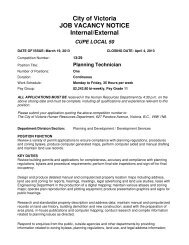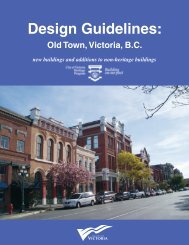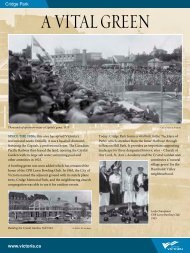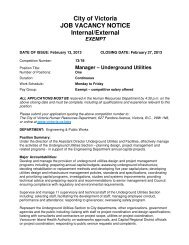Roundhouse Design Guidelines - Victoria
Roundhouse Design Guidelines - Victoria
Roundhouse Design Guidelines - Victoria
You also want an ePaper? Increase the reach of your titles
YUMPU automatically turns print PDFs into web optimized ePapers that Google loves.
5.2 Sustainable Site Planning and <strong>Design</strong><br />
Site planning for <strong>Roundhouse</strong> utilizes a building massing strategy that enables<br />
the preservation of open spaces at the ground level for the development<br />
of pedestrian walkways, public gathering spaces, green spaces and resident<br />
amenity areas. The design of these open spaces should take into consideration<br />
sustainable development strategies.<br />
5.2.1 Stormwater Management<br />
Natural filtration of storm water though permeable paving and on-site bioswales<br />
enhances the natural environment and reduces the impact of new<br />
development on existing urban infrastructure and the natural environment.<br />
Stormwater management strategies should be included in each phase of<br />
development. Stormwater management strategies are encouraged in each<br />
phase of development as follows:<br />
• Utilize permeable paving and other permeable surfaces unless site<br />
remediation requirements and/or approved risk assessment strategies<br />
prevent such surfacing. Permeable paving absorbs water and allows it<br />
to penetrate to the sub-surface in order to replenish soil moisture and<br />
aquifers rather than letting it flow into storm drains. It reduces flooding<br />
and volume of polluted storm water that reaches local bodies of water.<br />
• Reduce the heat island effect on site by utilizing the following measures:<br />
• Provide shade by the use of street trees, overhangs, and building<br />
elements.<br />
• Utilize light-colored paving materials with an albedo of 0.30 or<br />
greater.<br />
• Minimize building and hard surface paving footprints.<br />
5.2.2 Sustainable Landscape <strong>Design</strong><br />
Landscape techniques that minimize maintenance and water requirements and<br />
reduce harmful fertilizer, herbicide, and pesticide use should be used.<br />
• Complete environmental site remediation of contaminated site areas. (The<br />
<strong>Roundhouse</strong> site has both groundwater and soil contaminants.)<br />
• Minimize disruption of the site by:<br />
• Protecting existing landscape features to help prevent soil<br />
erosion, maintain sources of natural cooling, divert waste from<br />
landfills, preserve nature and add value to the community.<br />
• Completing a landscape survey to determine the feasibility of<br />
preserving or relocating mature trees, shrubs and native<br />
vegetation.<br />
• Minimizing the development footprint and providing permanent<br />
open spaces to help protect the local ecosystem, conserve<br />
natural resources, and enhance the community.<br />
44<br />
R O U N D H O U S E D E S I G N G U I D E L I N E S J u l y 2 0 0 8




![Victoria-Changsha Friendship City Signing Ceremony [PDF - 143 KB]](https://img.yumpu.com/50875401/1/190x245/victoria-changsha-friendship-city-signing-ceremony-pdf-143-kb.jpg?quality=85)
![Victoria's Paralympic Torch Relay and Celebration Plans [PDF - 64 KB]](https://img.yumpu.com/49727313/1/190x245/victorias-paralympic-torch-relay-and-celebration-plans-pdf-64-kb.jpg?quality=85)

![Cecelia Ravine Park Management Plan [PDF - 1.4 MB] - Victoria](https://img.yumpu.com/46438167/1/190x245/cecelia-ravine-park-management-plan-pdf-14-mb-victoria.jpg?quality=85)

![View the House Names (Alphabetical List) [PDF - 64 KB] - Victoria](https://img.yumpu.com/46379892/1/190x245/view-the-house-names-alphabetical-list-pdf-64-kb-victoria.jpg?quality=85)


![View the list of Private Records (By Number) [PDF - 295 KB] - Victoria](https://img.yumpu.com/42964883/1/190x245/view-the-list-of-private-records-by-number-pdf-295-kb-victoria.jpg?quality=85)




![General Maps (By Subject) [PDF - 40 KB] - Victoria](https://img.yumpu.com/35594040/1/190x245/general-maps-by-subject-pdf-40-kb-victoria.jpg?quality=85)